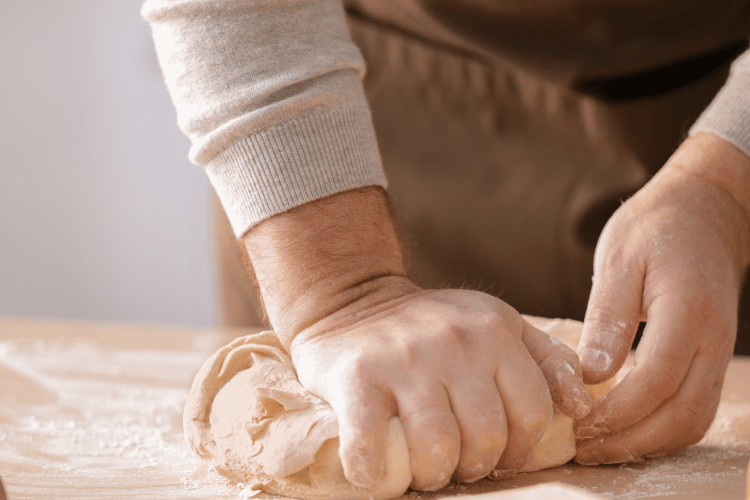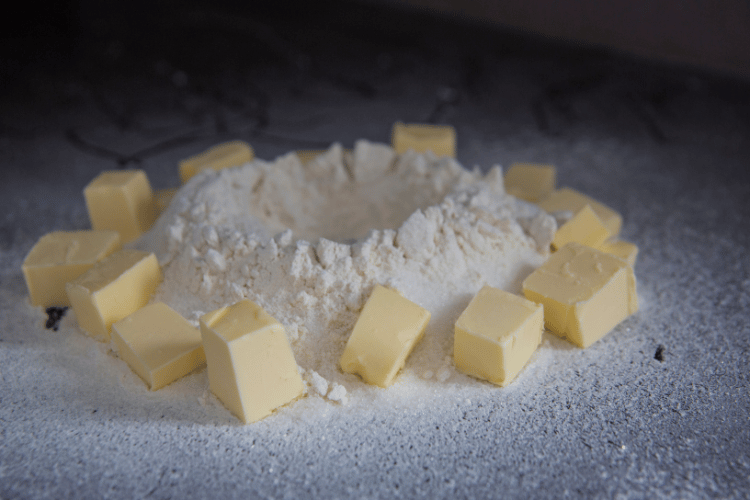Whether you’re making a stew, sauce, or soup, you want to create that creamy and rich consistency. Luckily, adding thickening agents like roux and beurre manie does the trick.
Now, you’re probably wondering, “What’s the difference?” Well, both mixtures differ in preparation, variations, and ease of creation.
While they serve the same purpose and offer a similar taste, a beurre manie and roux are made differently.
A beurre manie is made by kneading your ingredients. Meanwhile, a roux requires heat to mix the components. Stick around to learn more about the differences and similarities between a roux and a beurre manie.

What Is Beurre Manie?
Beurre manie is French for “kneaded butter.” If you’ve tasted French soups and sauces, you’ve likely noticed a touch of richness. That comes from the beurre manie addition.
Achieving effortless creaminess in your meals only takes a few ingredients. Creating beurre Manie involves kneading equal parts butter and all-purpose flour. You can then integrate the mixture into your soups and sauces for a thicker consistency.
You may have heard of other thickening combinations, like a slurry of equal parts water and cornstarch.
While that does create a thickened texture, it doesn’t offer the same rich flavor as the French beurre manie. Instead, it may make your sauce have a more gelatin-like texture, which can be unpleasant for some.
What Is Roux?

Like beurre manie, roux also carries French origins. It translates to “reddish-brown” or “browned butter.” The mixture contains equal parts of fat and flour.
You’ll need to mix the essential ingredients using heat to make the roux. It acts as an emulsifier when incorporating fats into liquid-based meals, like gumbo.
You can use a neutral oil or unsalted butter for the fat ingredient. It’ll create a thick and smooth mixture for your lasagnas, stews, sauces, and soups.
Two of the most popular uses of roux are in French cuisine. You can make a creamy bechamel or veloute sauce. Besides that, they also shine in other cultural dishes like Cajun and Japanese-origin foods.
For instance, you can’t skip the thickening solution in your Japanese Golden or Katsu curry recipe.
Beurre Manie vs. Roux: Differences
After knowing about each blend, you’ll want to know how to differentiate between them.
Preparation
The preparation process for beurre manie and roux sauces differ. The latter uses heat when incorporating the fat and flour, while the prior uses kneading. Here’s how you can prepare both.
How to Make a Beurre Manie
Prepare one tablespoon of flour and one tablespoon of butter. Keep the butter at room temperature to easily meld it into the flour. Don’t use a microwave to soften the butter. Otherwise, it could turn into a more liquid form than creamy.
Next, knead the two ingredients by hand or using a wooden spoon. Alternatively, you can use a food processor, but make sure your butter doesn’t melt into a liquid state from the heat.
After mixing, the beurre manie will feel sticky, but continue working through it until the components are well-incorporated. You’ll have a paste-like product. Then, plop it into your stew, sauce, or soup and whisk it until clump-free.
Your dish should be done when you no longer taste the flour, and your mixture becomes thicker. If you’ve made extra, you can enclose it in plastic wrap and freeze it for around three months. Make sure it’s cylindrical when wrapping it up. Before adding it to your dish, ensure it’s thawed and soft.
How to Make a Roux
Making a roux involves more steps compared to a beurre manie. First, melt the fat in a saucepan. Then, dust in flour particles. Allow the powder to become fully coated in the liquid. Mix the components using a wooden spoon and a Figure 8 technique.
Before adding it to your sauces, be sure to let it cool. You should end up with a smooth and shiny consistency that coats the back of your spoon. The most critical step to making a roux is mixing the ingredients well.
Otherwise, you may leave bits of flour clumped in your roux that can potentially burn and alter its taste. Besides that, if you’ve made too much, you can store it in an airtight container and keep it for up to one month.
Ease of Preparation
You might be wondering, “Which is easier to make?” In this case, it’s the beurre manie. Preparing it involves no heat and mixing equal parts of fat and flour by hand or spoon. Creating a roux requires more experience.
You need to mix the ingredients on heat and find the perfect balance of portions. Plus, you need to know when to stop to achieve the roux variation you need, whether light or dark.
Another point worth mentioning is that making beurre manie means one less dish to clean. Overall, a beurre manie is easier to create and takes less time and effort.
Variations
A beurre manie doesn’t have much variation, since it only involves kneading butter and flour. On the other hand, roux mixtures have more variety. For example, you can create a light, brown, and dark roux.
These variations differ in taste. The darker your roux gets, the more of a nutty flavor you’ll achieve. Dark roux is usually used in gumbo to create a deeper flavor profile. Some describe the taste of it as a campfire coffee with notes of tobacco.
Meanwhile, the light variations provide more richness and creaminess with a subtle flavor. It’s more similar to a beurre manie’s addition.
Ingredients
A beurre manie and roux use the same ingredients of fat and flour. Nonetheless, unlike the prior, a roux can use substitutes.
You can alternate the fat for unsalted butter, ghee, and animal fat. You can use unflavored neutral vegetable oils like sunflower and canola, but it’s not as recommended as other types of fat. It’s because once your roux cools, the oils tend to separate and break the sauce.
Besides that, portions can also vary. Some chefs prefer adding more flour than fat to create a more effective thickening solution.

Beurre Manie vs. Roux: Similarities
Despite all the differences mentioned, a beurre manie and roux bear some resemblances, from their taste to application.
Application
You can add a beurre manie to the same dishes as a roux. It can be a stew, soup, sauce, or other liquid-based dish. That said, each thickener has its preferred application.
For instance, a lot of people would reach for a roux recipe when cooking a bechamel sauce. That said, a beurre manie is versatile. You can plop your butter-flour balls into any stew or soup dish for added texture. Plus, you can use either mixture as a base for gravy.
Purpose
A beurre manie and roux have the same purpose, which is to thicken a dish’s consistency. They both add an extra element of creaminess and richness to your sauces and soups. A thickened texture equates to more bursts of flavor as well.
Taste
When it comes to taste, most may prefer using a roux. Since it’s initially cooked, the raw flour taste is usually non-existent. Meanwhile, it could be more challenging to get rid of the floury taste when adding a beurre manie to your dish.
Nevertheless, when done right, both beurre manie and roux should offer the same taste and richness. When incorporating your beurre manie, be sure to cook off the flour for no more than ten minutes. In turn, taste-wise, both mixtures are similar.
Beurre Manie vs. Roux: Which One Should You Choose?
One of the discernible differences between a roux and a beurre manie is the browning process. A roux provides room for a more complex and deeper taste after staying longer in heat. In turn, if you’re making a flavor-packed dish like a curry or gumbo, a roux might be your best bet.
On the other hand, if you’re making a mushroom cream soup and don’t want an overpowering element, you can stick to adding a few balls of beurre manie. Alternatively, you can use a light roux as well.
Apart from that, if you’re choosing based on ease of preparation, then a beurre manie is the clear winner. You only need to use a couple of ingredients found on your kitchen counter and knead them by hand or with a wooden spoon or rolling pin.
Overall, both options will offer an enhanced thickness and texture to your stews and soups. Whether you want the added flavor of a brown roux or the viscosity of a beurre manie, they’ll elevate your meal.
Final Thoughts
What’s the difference between a roux and a beurre manie? In short, it primarily comes down to preparation. A beurre manie is made by kneading butter and flour to create portioned balls to add to your cooking liquid dish.
A roux is made with extra steps, involving cooking the fat until it melts, sprinkling the flour, and mixing until the ingredients are well-incorporated. Either way, both mixtures will provide your dish with a glossy sheen and richer flavor.
- How To Fill a King Cake With Bavarian Cream - April 15, 2024
- Dealing With Mold on Oyster Mushrooms - April 9, 2024
- What Meat Goes With Pumpkin Ravioli? (Ravishing Ravioli Combos) - March 15, 2024
